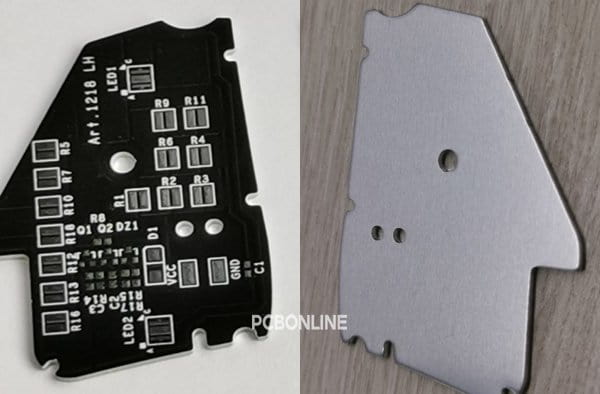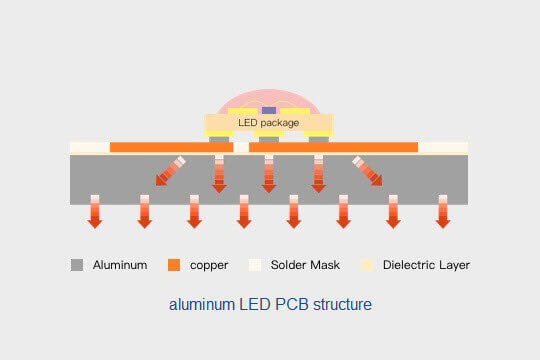Aluminum PCB is a metal-core circuit board that is popularly used for LED lights. It has a simpler structure and higher thermal conductivity than an FR4 PCB.
This blog gives a full introduction to aluminum PCBs. When you design an aluminum PCB for manufacturing, PCB structures, laminates, thickness, and thermal conductivity are the key considerations. To answer all possible questions from a client, the one-stop aluminum PCB manufacturer PCBONLINE reveals everything about aluminum PCBs below.
Part 1: What is Aluminum PCB
Aluminum PCB, also called aluminum base PCB, aluminum substrate PCB, or aluminum core PCB, is a printed circuit board that uses aluminum as its substrate material.
Aluminum PCBs have been developed and put in use for more than 50 years. For reliability and cost-effectiveness, aluminum PCB is the top PCB option for LEB lighting.

For reliability and cost-effectiveness, aluminum PCB is considered the first PCB option for LED lighting.
Compared with other PCBs with up to 64 circuit layers, aluminum PCBs have a simpler structure. The circuit layer number of aluminum PCBs ranges from 1 to only 4.
Why do aluminum PCBs have only up to 4 circuit layers? Because aluminum PCBs are designed to dissipate heat. On both sides of the aluminum base, the dielectric (prepreg or PP) layer number is up to 2. so the circuit layer number of an aluminum PCB is up to 4.
However, even with the 4-circuit-layer limit, the design of aluminum PCBs can be diverse. Aluminum PCB can have the following structures:
One-layer aluminum PCB with single component mounting side
![]()
A one-layer single-sided aluminum PCB has the simplest structure and is the easiest to make. The circuit is directly etched out on the copper layer of the aluminum laminate.
The heat transfers from the components to the copper layer, to the PP layer, to the aluminum base.
Two-layer aluminum PCB with single component mounting side
![]()
A two-layer aluminum PCB with one component mounting side has two copper and PP layers.
The heat transfers from the components to the first copper layer, to the first PP layer, to the second copper layer, to the second PP layer, and then to the aluminum base.
Two-layer aluminum PCB with dual component-mounting sides
![]()
When a single side can't route all circuits, an aluminum PCB can be designed as two-sided. The structure of a two-layer dual-sided aluminum PCB is similar to a two-layer dual-sided FR4 PCB. But between the copper PTH holes and the aluminum base is filled with resin.
The heat transfers from the LED components to the copper layer, to the PP layer, and then to the aluminum base.
Four-layer aluminum PCB with dual component-mounting sides
![]()
On both sides of a four-layer aluminum PCB, there are two copper layers and two PP layers.
The heat transfers from the components to the external copper layer, to the first PP layer, to the second copper layer, to the second PP layer, and then to the aluminum base. So the thermal conductivity of a four-layer PCB is smaller than a single-layer PCB and a two-layer dual-sided PCB.
Besides, a four-layer aluminum PCB can even be high-density-interconnected (HDI) with blind/buried microvias. For example, PCBONLINE once designed and manufactured an HDI four-layer aluminum PCB project for one customer. You can see the product image below.
![]()
Apart from the above rigid aluminum PCBs, you can also order flexible aluminum PCBs from PCBONLINE. Flexible aluminum PCBs are also rigid at first, but during manufacturing, we process to make the aluminum board bendable. The copper-clad we use for flexible aluminum PCBs is rolled annealed copper or electrolytic copper.
![]()
Though aluminum PCBs have a limited circuit layer range, you can fully use creativity in developing your aluminum PCB lighting products. PCBONLINE will provide one-on-one design/engineering assistance and one-stop manufacturing to meet every demand for your products.
Part 2: Aluminum PCB Laminates and Thicknesses
All aluminum PCB laminates have three layers: the aluminum base, the PP layer, and the copper layer.
According to the aluminum base hardness differences, we have these aluminum PCB laminates available for PCB production:
- 1006: 99% pure aluminum, low density, but low strength.
- 3003: Al-Mn alloy, higher strength than 1006, applications include refrigerators and air conditions.
- 5952: Al-Mg alloy, high strength, applications include electronic product boxes, automotive, and pressure containers.
- 6061: Al-Mg-Si alloy, excellent solderability, and toughness, applications include aerospace, communication, automotive, and commercial electronics.
Their hardness increases in the above order.
According to different laminate suppliers, aluminum laminates include Ventec, Shengyi, Polytronics, Totking, Arlon, Laird, Berquist, Yugu, etc. Among them, we have cooperation with Ventec. And Yugu is PCBONLINE's aluminum laminate factory.
![]()
Please see the aluminum PCB laminate thickness available for PCBONLINE's PCB production. (I only list the Ventec laminates here. If you want PCBs using other laminates, please ask PCBONLINE by email at info@pcbonline.com or from the online chatting window on the right.)
|
Aluminum PCB laminate
|
Dielectric thickness
|
Aluminum thickness
|
Copper foil weight
|
Thermal conductivity
|
|
VT-4B7 SP
|
Selective
|
0.6mm, 0.8mm, 1.0mm, 1.2mm, 1.5mm, 2.0mm, 3.0mm
|
1/3oz, Hoz, 1oz, 2oz, 3oz, 4oz, 6oz
|
7W/mK
|
|
VT-4B7
|
.003" (75μm), .004" (100μm), .006" (150μm)
|
1.0mm, 1.5mm, 2.0mm, 3.0mm
|
Hoz, 1oz, 2oz, 3oz, 4oz, 5oz, 6oz
|
7W/mK
|
|
VT-4B5 SP
|
40μm
|
0.6mm, 0.8mm, 1.0mm, 1.2mm, 1.5mm, 2.0mm, 3.0mm
|
1/3oz, Hoz, 1oz, 2oz, 3oz, 4oz, 6oz
|
4.2W/mK
|
|
VT-4B5H
|
0.002" (50μm), 0.003" (75μm), 0.004" (100μm), 0.006" (150μm), 0.008" (200μm)
|
1.0mm, 1.5mm, 2.0mm, 3.0mm
|
1.0mm, 1.5mm, 2.0mm
|
4.2W/mK
|
|
VT-4B5L
|
0.002" (50μm), .004" (100μm)
|
1.5mm
|
1oz, 2oz, 3oz
|
3.6W/mK
|
|
VT-4B5
|
.002" (50μm), .003" (75μm), .004" (100μm), .006" (150μm), .008" (200μm)
|
1.0mm
|
Hoz, 1oz, 2oz, 3oz, 4oz, 5oz, 6oz
|
4.2W/mK
|
|
VT-4B3
|
.002" (50μm), .003" (75μm), .004" (100μm), .005" (125μm), .006" (150μm), .007" (180μm)
|
1.0mm
|
1/3oz, Hoz, 1oz, 2oz, 3oz, 4oz, 5oz, 6oz
|
3.0W/mK
|
|
VT-4B1
|
.002" (50μm), .004" (100μm)
|
1.0mm
|
Hoz, 1oz, 2oz
|
1.0W/mK
|
|
VT-5A2
|
.003"(80um), .004"(100um), .006"(150um), .008"(200um), .012"(300um))
|
/
|
Hoz, 1oz, 2oz, 3oz
|
2.2W/mK
|
|
VT-4A2H PP
|
.003"(80um), .004"(100um), .006"(150um), .008"(200um)
|
/
|
Hoz, 1oz, 2oz, 3oz
|
2.2W/mK
|
|
VT-4A2H IMS
|
.003“ (75μm), .004“ (100μm), .005“ (125μm), .006“ (150μm), .008“ (200μm)
|
1.0mm
|
Hoz, 1oz, 2oz, 3oz, 4oz, 6oz, 10oz
|
2.2W/mK
|
Part 3: PP Layer - the Key to Aluminum PCB Thermal Conductivity
Aluminum PCBs were developed for high-thermal applications that traditional FR4 PCBs can't withstand. Usually, when the temperature reaches about 180℃, the FR4 PCB substrate starts to become soft, and the board loses mechanical strength.
In contrast, aluminum PCBs have a thermal conductivity of 1W/mK to 9W/mK and can withstand a temperature of 400℃. So aluminum PCBs are usually used for thermal dissipation, especially in LED lamps.
The aluminum PCB plays an important role in protecting the LED dies from overheating.

When LEDs transform electric energy into light, a great amount of heat is generated from the P-N joint. The thermal dissipates from the P-N joint to the pins, then to the circuit board, and finally mainly to the metal box.
Thermal dissipation of copper and aluminum is extremely fast, but the rate gets smaller for the PP layers. So it is the PP layer that decides the thermal dissipation of the aluminum circuit board.
The PP layer is made of a polymer filled with ceramics. However, the unique formula is a secret for aluminum laminate makers.
At PCBONLINE, we can customize the thermal conductivity of aluminum PCBs. You can send your requirements to PCBONLINE, and we will make the PCB thermal conductivity meet your expectations.
Part 4: Competitive Pricing - Aluminum PCB Manufacturing Only $30/㎡
PCBONLINE provides one-stop aluminum PCB manufacturing and assembly at the most competitive pricing. All of our aluminum PCBs are manufactured and assembled at high standards without quality sacrifice. Especially, if you order bulky production, the aluminum PCB price is only $30 per square meter! How do we make it?
Here are the secrets behind PCBONLINE's aluminum PCB manufacturing and assembly:
- We have achieved industry 4.0 full-automatic production throughout the whole manufacturing process.
- We have long-term cooperation with the laminate manufacturer Ventec, and we have our own laminate factory Yugu.
- Besides Ventec and Yugu, laminates from Shengyi, Arlon, Totking, Polytronics, and Bergquist are also available for production.
- Ability to customize aluminum PCB thermal conductivity from 1W/mK to 9W/mK.
- PCBONLINE has two large PCB manufacturing bases, one PCB assembly factory, and a laminate factory for aluminum PCBs.
PCBONLINE provides aluminum PCB prototyping, bulky production and assembly, component sourcing, and end-product assembly. If you have any aluminum PCB needs, please feel free to send your Gerber to PCBONLINE by email at info@pcbonline.com.
Conclusion
An aluminum PCB uses aluminum as its PCB substrate and has good thermal dissipation. Aluminum PCBs are cost-effective and reliable circuit boards for lighting. PCBONLINE provides one-stop 1W/mK to 9W/mK aluminum PCB manufacturing from 1 to 4 layers. If you have any needs, you are welcome to get an instant quote from PCBONLINE.




